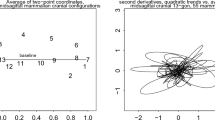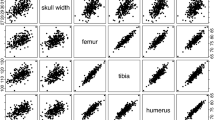Abstract
It is now well documented that biology needs morphometrics. Morphometrics can provide useful and often unexpected information about development and growth, functional—especially mechanical—adaptation, and evolutionary difference and relationship. Such studies often apply coordinate data from anatomical landmarks. Recently semi-landmarks and sliding landmarks increase information content, especially of apparently featureless regions (e.g., skull vault). Yet, how we landmark our materials limits the results we get and the questions we ask. Here we show different landmarking schemes leading to different equivalences between specimens and different results. Geometric morphometric methods often treat landmarks as points on rubber sheets. Distortions of the sheets are often visualized by techniques like thin plate splines showing changes or differences as stretches or contractions. The statistics of morphometrics can handle these. Further consideration of anatomical landmarks, however, implies that real biologies are sometimes more complex. Sometimes two-dimensional rubber sheets of anatomies contain cusps or holes representing appearances or disappearances of structures. In three dimensions, equivalent rubber blocks may show not only appearances or disappearances but also reversals of positions of structures. Such phenomena are generally ignored in landmarks and analyses. We show that in some cases morphometrics can take account of such matters. But we also suggest that sometimes these modifications from elastic analogues are so complex that new methods may be required for our morphometric packages. It is in this sense that improvement of morphometrics needs deeper understanding of biology.
Similar content being viewed by others
References
Bookstein FL (1978) The Measurement of Biological Shape and Shape Change. New York: Springer.
Bookstein FL (1989) Principal warps: Thin-plate splines and the decomposition of deformations. IEEE Transactions in Pattern Analysis and Machine Intelligence 11: 567–585.
Bookstein FL (1991) Morphometric Tools for Landmark Data: Geometry and Biology. Cambridge: Cambridge University Press.
Bookstein FL (1997) Landmark methods for forms without landmarks: Localizing group differences in outline shape. Medical Image Analysis 1: 225–243.
Dryden IL, Mardia KV (1998) Statistical Shape Analysis. Chichester, UK: John Wiley.
Gunz P, Mitteroecker P, Bookstein FL (2005) Semilandmarks in three dimensions. In: Modern Morphometrics in Physical Anthropology (Slice DE, ed), 73–98. Chicago: University of Chicago Press.
Huxley J (1932) Problems of Relative Growth. London: Methuen.
Kendall DG (1984) Shape-manifolds, Procrustean metrics and complex projective spaces. Bulletin of the London Mathematical Society 16: 81–121.
Kent JT (1984) The complex Bigham distribution and shape analysis. Journal of the Royal Statistical Society B 56: 285–299.
Kent JT, Mardia KV (1987) Consistency of Procrustes estimators. Journal of the Royal Statistical Society Series B 59: 281–290.
Koestler A (1968) The Sleepwalkers. London: Hutchinson.
Mitteroecker P, Bookstein F (2007) The conceptual and statistical relationship between modularity and morphological integration. Systematic Biology 56: 818–836.
Mitteroecker P, Gunz P, Bookstein FL (2005) Heterochrony and geometric morphometrics: A comparison of cranial growth in Pan paniscus versus Pan troglodytes. Evolution and Development 7: 244–258.
O’Higgins P (1992) Studies of craniofacial growth and development: A review. Proceedings of the Australasian Society for Human Biology 5: 329–343.
O’Higgins P (2000) Quantitative approaches to the study of cranio-facial growth and evolution: Advances in morphometric techniques. Linnean Society Symposium Series 20: 187–206.
O’Higgins P, Jones N ([1999] updated versions 2004, 2006) Morphologika: A computer program for three-dimensional geometric morphometrics. University of York. http://www.york.ac.uk/res/fme
Oxnard CE (1969) Mathematics, shape and function: A study in primate anatomy. American Scientist 57: 75–96.
Oxnard CE (1983/1984) The Order of Man: A Biomathematical Anatomy of the Primates. Hong Kong: Hong Kong University Press (1983), New Haven, CT: Yale University Press (1984).
Oxnard CE (2000) Morphometrics of the primate skeleton and the functional and developmental underpinnings of species diversity. Linnean Society Symposium Series 20: 207–234.
Oxnard CE (2008) Ghostly Muscles, Wrinkled Brains, Heresies and Hobbits. Singapore: World Scientific Press.
Oxnard CE, Franklin D (2008) Ghosts of the past. I: Some muscles and fasciae in the head domain. Folia Primatologica 79: 429–440.
Perez SI, Bernal V, Gonzalez PN (2006) Differences between sliding semi-landmark methods in geometric morphometrics, with an application to human craniofacial and dental variation. Journal of Anatomy 208: 769–784.
Polly PD (2008) Adaptive zones and the Pinniped ankle: A 3D quantitative analysis of Carnivoran Tarsal Evolution. In: Mammalian Evolutionary Morphology: A Tribute to Frederick S. Szalay (Sargis E, Dagosto M, eds), 165–194. Dordrecht, the Netherlands: Springer.
Rohlf FJ (2000a) On the use of shape spaces to compare morphometric methods. Hystrix, Italian Journal of Mammology 11: 8–24.
Rohlf FJ (2000b) Statistical power comparisons among alternative morphometric methods. American Journal of Physical Anthropology 111: 463–478.
Rohlf FJ (2004) TPSrelw. http://life.bio.sunysb.edu/morph/
Slice DE (2005) Modern Morphometrics in Physical Anthropology. Chicago: University of Chicago Press.
Thom R (1972) Stabilité structurelle et morphogénèse. Essai d’une théorie générale des modèles. New York: Benjamin.
Thom R (1975) Structural Stability and Morphogenesis. Reading, MA: Benjamin.
Thompson DW (1917) On Growth and Form. Cambridge: Cambridge University Press.
Author information
Authors and Affiliations
Corresponding author
Rights and permissions
About this article
Cite this article
Oxnard, C., O’Higgins, P. Biology Clearly Needs Morphometrics. Does Morphometrics Need Biology?. Biol Theory 4, 84–97 (2009). https://doi.org/10.1162/biot.2009.4.1.84
Received:
Accepted:
Published:
Issue Date:
DOI: https://doi.org/10.1162/biot.2009.4.1.84




